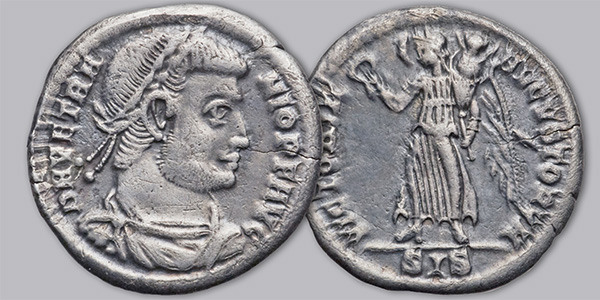
By Lorie Ann Hambly for Heritage Auctions ……
Vetranio (we do not know a first or family name) was born to humble parents in Moesia, probably in the 290s CE. He entered the army and served with distinction under the mighty Constantine I (306-337), the first Christian ruler of Rome, who even during his lifetime came to be called “Magnus” — The Great. Upon Constantine’s death, the Roman Empire was split between his three surviving sons: Constantine II, Constantius II, and Constans. In 340 CE, a spate of sibling bloodletting eliminated Constantine II and the survivors divvied up the spoils, with the West going to Constans, who late in his reign made Vetranio Master of Infantry (Magister Peditum) for Pannonia.
However, a coup toppled Constans early in 350, replacing him with the Frankish-born Magnentius, who had no blood connection to the Constantinian dynasty. Magnentius quickly consolidated his power base in Gaul and Italy, and set about preparing for the inevitable response of Constantius II, Emperor of the East.
Commanding a large army at a critical crossroads between the two rivals, Vetranio was unsure whether to remain loyal to the house of Constantine, which he had served for three decades, or to back Magnentius, who was closer and already making overtures to his troops.
At this point Constantia, the eldest sister of Constantius, enters the picture. She persuaded Vetranio that he could best support her brother by temporarily claiming the Imperial title for himself, thus keeping the Pannonian army from backing Magnentius. On March 1, Vetranio’s soldiers duly proclaimed him Augustus at Mursa. Constantia sent her brother a letter explaining the situation, which he received at Edessa in Syria. He responded as she wished, by recognizing Vetranio as a fellow “legitimate” ruler opposed to the “usurper” Magnentius. He sent along a diadem, an imperial purple cloak, and large sum of money to pay the Balkan troops. Constantius also instructed Vetranio to block Magnentius’ eastward advance until he could deal with the situation in person.
For 10 months, Vetranio played the man in the middle, alternately professing loyalty to Constantius and telling Magnentius he might be open to negotiating an alliance with him. In December of 350, Constantius marched west and met Vetranio at Naissus in modern Serbia. On Christmas day, both emperors mounted a platform before the assembled armies, where Vetranio formally abdicated the throne. Constantius praised Vetranio’s loyalty (although he also ridiculed him as an “old fool” for thinking he could hold onto power for very long) and pensioned him off to an opulent estate in Bithynia.
“Old fool” he may have been, but Vetranio had brilliantly played the difficult hand dealt him, had briefly been counted among the rulers of the Roman world, and enjoyed a far more sanguine fate than most other men who claimed the deadly purple.
Having two mints under his control, Siscia and Thessalonica, Vetranio struck coins both in his own name and that of Constantius II. His bronze coinage is scarce, the silver rare, the gold exceptionally so. Interestingly, his obverse portraiture eschews the by-now-usual imperial diadem in favor of an old-fashioned laurel wreath, perhaps a visual clue of his subordinate status. The reverse shows Victory crowning an emperor (Constantine the Great) in military dress, along with the inscription, “HOC SIGNO VICTOR ERIS” (“In this sign, you will conquer”).
This is a direct reference to the “divine vision” that supposedly convinced Constantine the Great to support the Christians and their God before the Battle of the Milvian Bridge in 312 CE. Constantine’s biographers Lactantius and Eusebius give two different versions of the vision: Lactantius says Constantine had a dream before the battle instructing him to have his men inscribe their shields with the “heavenly sign” of a staurogram, a cross topped by a P, while Eusebius claims Constantine actually saw a cross of light in the heavens with the Greek words En Touto Nika, a Greek version of the Latin phrase on Vetranio’s coin.
Some historians doubt whether Constantine really ever experienced either version or simply made them up years later to explain his sudden decision to back the Christian cause. Whatever the truth of the matter, Vetranio’s coin proves that by 350 CE the story of Constantine’s vision was widely accepted.
Ancient Roman Coins of Vetranio Currently Available on eBay
[wpebayads]




